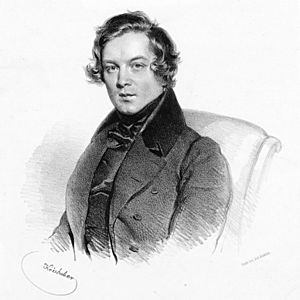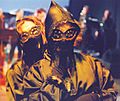Carnaval facts for kids
Carnaval, Op. 9, is a famous music piece for solo piano. It was written by the German composer Robert Schumann between 1834 and 1835. The full title means "Little Scenes on Four Notes." This music is a collection of short songs that paint a picture of people at a fun, masked festival.
Schumann used music to show himself, his friends, and characters from old Italian plays called commedia dell’arte. The whole piece is built around four special musical notes: A, E-flat, C, and B. These notes spelled out "A-S-C-H" in German, which was important to Schumann. Carnaval is like a musical story of a big, fancy masked ball during the carnival season.
During Schumann's time, this music was rarely played in public. Both he and his wife, Clara, thought his piano pieces were too hard for most people. However, another famous musician, Franz Liszt, did play parts of Carnaval in Leipzig in 1840. Today, Carnaval is one of Schumann's most popular works. In the early 1900s, it was even turned into music for a ballet by the Ballets Russes, starring the dancer Nijinsky.
Contents
Carnival is a lively festival celebrated in many parts of the world. It usually happens just before the Christian season of Lent. During Lent, people often give up certain things. Carnival is a time for big parties, parades, and fun before that quiet period begins.
Carnival Traditions Around the World
Carnival celebrations are different in every country. Many involve dressing up in costumes and masks. People often dance, sing, and enjoy special foods.
Famous Carnivals
- Rio Carnival: This huge carnival in Rio de Janeiro, Brazil, is known for its amazing samba parades. Thousands of dancers and musicians fill the streets.
- Venice Carnival: In Venice, Italy, people wear beautiful, traditional masks and costumes. The city becomes a magical place filled with mystery.
- Mardi Gras: Celebrated in New Orleans, USA, Mardi Gras means "Fat Tuesday." It's famous for its colorful parades, beads, and lively music.
- Carnival of Santa Cruz de Tenerife: This carnival in Spain is one of the biggest in the world. It features a Queen of the Carnival contest and many street parties.
Music and Dance in Carnival
Music is a huge part of carnival. Different regions have their own special music styles.
- In Brazil, samba music and dance are central to the celebrations.
- In the Caribbean, calypso and soca music get everyone dancing.
- Many carnivals feature marching bands, drums, and traditional folk music.
Costumes and Masks
Dressing up is a key part of carnival fun.
- People wear bright, colorful costumes, often with feathers, glitter, and sequins.
- Masks are worn to hide identities and add to the festive mystery.
- Some costumes are very elaborate and can take months to create.
Images for kids
-
Carnival in Rome circa 1650
-
Rio's carnival is the largest in the world according to Guinness World Records.
-
The traditional carnival of Acireale, Sicily
-
Carnival on Ice at the Kipdorppoort Moats in Antwerp, c. 1620
-
Carnival in Venice, by Giovanni Domenico Tiepolo, 1750
-
Riderless Racers at Rome by Théodore Géricault. From the mid-15th century until 1882, spring carnival in Rome closed with a horse race. Fifteen to 20 riderless horses, originally imported from the Barbary Coast of North Africa, ran the length of the Via del Corso, a long, straight city street, in about 21⁄2 minutes.
-
Recife Carnival, in the capital city of the State of Pernambuco, Recife
-
Carnival circuit of the city of Salvador
-
Carnival in Rincon (Bonaire) (2018)
-
The Blacks and Whites' Carnival in Pasto
-
Traditional cojuelo mask of the Dominican carnival in La Vega, Dominican Republic.
-
Carnival parade in Latacunga city.
-
Morenada dance, in the Carnival of Juliaca – Peru
-
Masqueraders chipping on Carnival Tuesday in Port of Spain during Trinidad and Tobago Carnival
-
Main square in Rijeka during Carnival
-
"Coprnice" (Witches) from Međimurje County, Northern Croatia
-
Reitenderle, der Grundholde, Hudelmale, Schnarragagges; popular Fasnet characters from Kisslegg im Allgäu, Swabia
-
From the Monstercorso on Güdisdienstag's evening in Lucerne (2009)
-
The float of the King Carnival parading in Patras, Greece
-
Ladies on their way to the historic Bourboulia ball in Patras, Greece wearing the dómino costumes unique to that ball.
-
The Battle of the Oranges at the carnival of Ivrea
-
Carnival procession in Valletta on Malta
-
The Fight Between Carnival and Lent, Pieter Bruegel, 1559
-
A dancer in the Carnival of Madeira, on the island's capital Funchal
-
Boris Kustodiev's painting of Maslenitsa
-
The Burial of the Sardine, Francisco Goya, c. 1812
-
A choir singing in the Carnival of Cádiz
-
Vidalot is the last night of revelry before Ash Wednesday in Vilanova. Water color painting by Brad Erickson.
See also
 In Spanish: Carnaval para niños
In Spanish: Carnaval para niños



























































